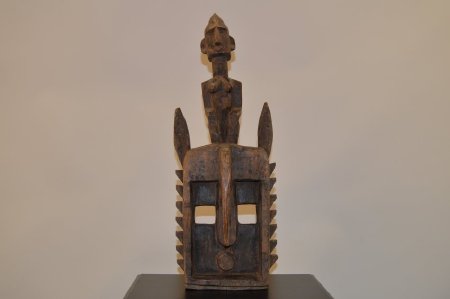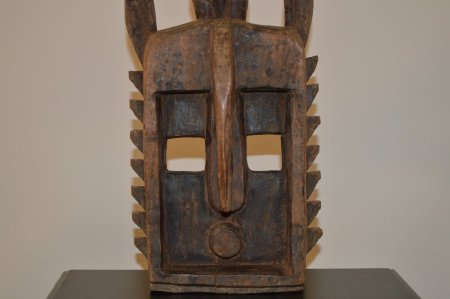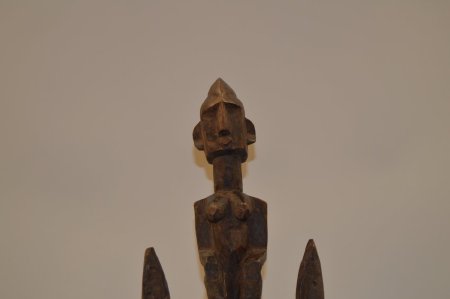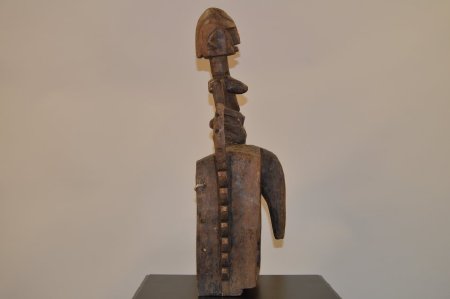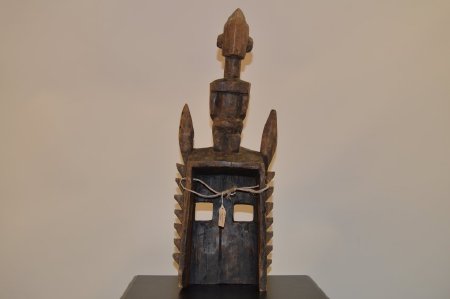Title:
Dogon Walu Antelope Mask
Object Name:
Mask, Face, Walu
Other Name:
Mask, Dance
Place of Origin:
Dogon, Mali, Africa
Provenance:
Aboriginal Indigenous Art.
There are nearly eighty styles of masks, but their basic characteristic is great boldness in the use of geometric shapes, independent of the various animals they are supposed to represent. The structure of a large number of masks is based on the interplay of vertical and horizontal lines and shapes. Another large group has triangular, conic shapes. All masks have large geometric eyes and stylized features. The masks are often polychrome, but on many the color is lost; after the ceremonies they were left on the ground and quickly deteriorated because of termites and other conditions. The Dogon continue an ancient masquerading tradition, which commemorates the origin of death. According to their myths, death came into the world as a result of primeval man’s transgressions against the divine order. Dama memorial ceremonies are held to accompany the dead into the ancestral realm and restore order to the universe. The performance of masqueraders – sometimes as many as 400 – at these ceremonies is considered absolutely necessary. In the case of the dama, the timing, types of masks involved, and other ritual elements are often specific to one or two villages and may not resemble those seen in locations only several miles distant. The masks also appear during baga—bundo rites performed by small numbers of masqueraders before the burial of a male Dogon. Dogon masks evoke the form of animals associated with their mythology, yet their significance is only understood by the highest ranking cult members whose role is to explain the meaning of each mask to a captivated audience.
There are nearly eighty styles of masks, but their basic characteristic is great boldness in the use of geometric shapes, independent of the various animals they are supposed to represent. The structure of a large number of masks is based on the interplay of vertical and horizontal lines and shapes. Another large group has triangular, conic shapes. All masks have large geometric eyes and stylized features. The masks are often polychrome, but on many the color is lost; after the ceremonies they were left on the ground and quickly deteriorated because of termites and other conditions. The Dogon continue an ancient masquerading tradition, which commemorates the origin of death. According to their myths, death came into the world as a result of primeval man’s transgressions against the divine order. Dama memorial ceremonies are held to accompany the dead into the ancestral realm and restore order to the universe. The performance of masqueraders – sometimes as many as 400 – at these ceremonies is considered absolutely necessary. In the case of the dama, the timing, types of masks involved, and other ritual elements are often specific to one or two villages and may not resemble those seen in locations only several miles distant. The masks also appear during baga—bundo rites performed by small numbers of masqueraders before the burial of a male Dogon. Dogon masks evoke the form of animals associated with their mythology, yet their significance is only understood by the highest ranking cult members whose role is to explain the meaning of each mask to a captivated audience.
Description:
Wooden antelope mask, with rectangular recessed face. Large square eyeholes, tubular mouth and long downward projecting nose, carved away from the face. Edges of the face are decorated with two rows of raised triangles and two diamond—shaped ears a the top corners. Female statue kneeling on top center of head. Entire surface covered in dark brown patina.
Collection:
Guy Mace Collection, (Turblex Company)
Material:
Wood W/Patina
Used:
Ritually Used
Technique:
Carving / Painting
Owned:
Art Department, Missouri Southern State University
Accession#:
2015.2.78
